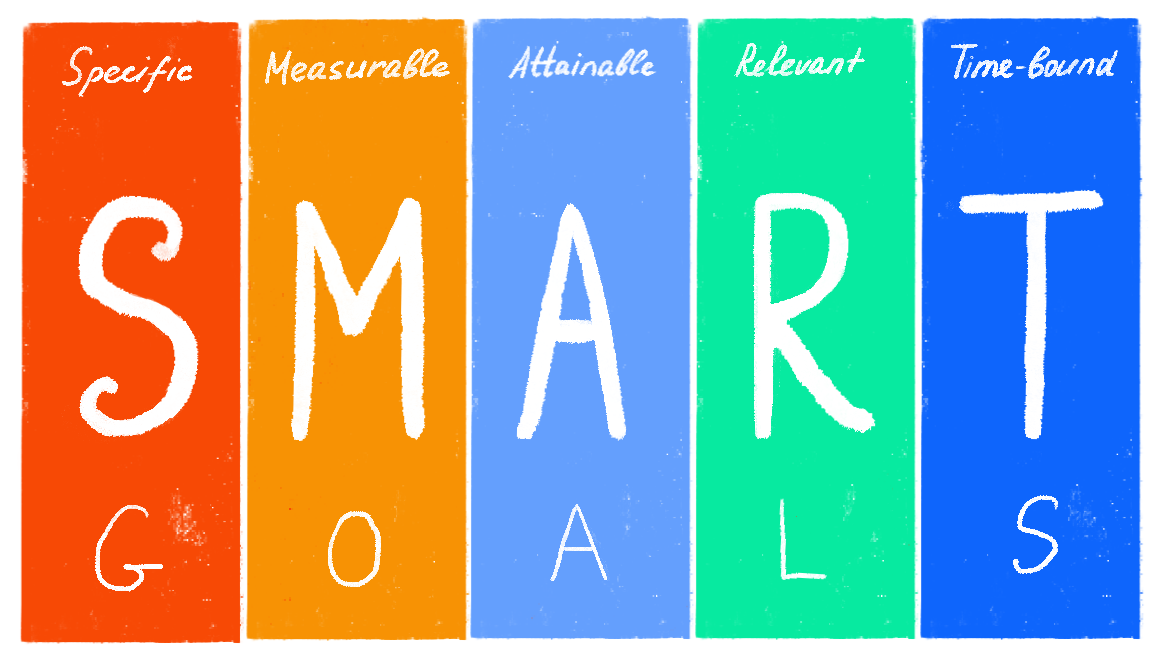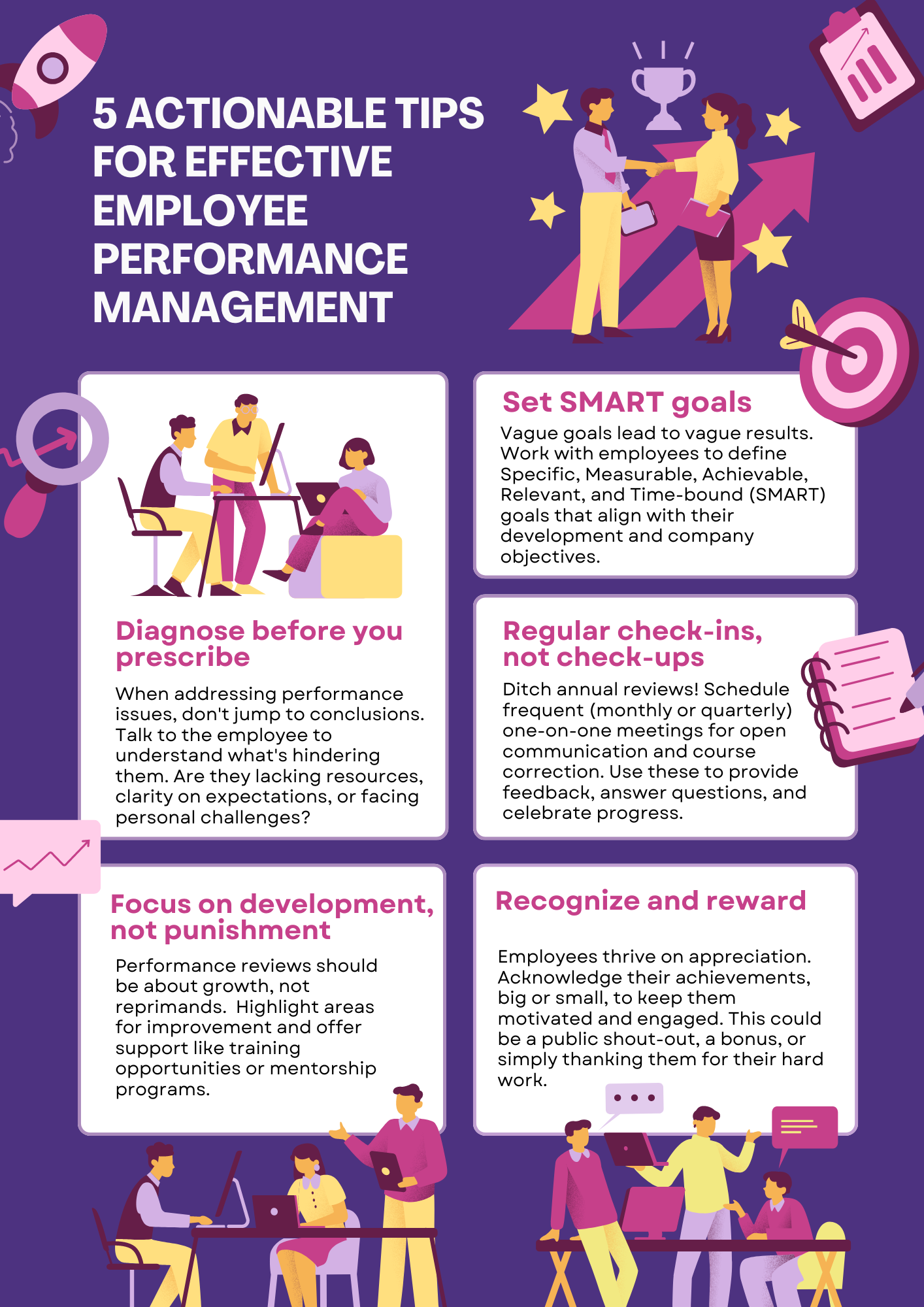Employee Performance Management — Tips, Benefits and Strategies
Employee performance management is critical for the success of any organization. Learn about the definition, tips, and benefits of effective performance management to streamline your approach and drive employee success.

Thriving organizations are built on the foundation of a high-performing workforce.
Hence, being a means to drive business growth and achieve organizational goals, effective employee performance is crucial for the success of an organization.
Why it is important: It directly impacts productivity, customer satisfaction, and overall business results. It also influences employee morale, retention, and the company's competitive advantage in the market.
What is Employee Performance Management?

Employee performance management definition implies the ongoing process of identifying, measuring, managing, and developing the performance of employees in an organization by:
- setting clear goals and expectations
- providing regular feedback
- evaluating performance
- offering opportunities for growth and development.
Key Performance Indicators (KPIs) for Measuring Employee Performance
Goal Achievement
Tracking how well employees manage and meet objectives (clarity, meeting deadlines, alignment with general goals).

Work Prioritization & Completion
Evaluating efficiency in prioritizing tasks and completing work (identify improvement areas).
Accuracy & Standards
Monitoring the accuracy, attention to detail, and adherence to company standards in employee work.
Employee Commitment
Measuring employee engagement, enthusiasm, and willingness to contribute (work, peers, organization).
Is there a difference between employee performance and employee engagement?
- Employee Performance refers to the effectiveness of an employee's actions in accomplishing their assigned tasks and responsibilities. It's typically measured through key metrics like productivity, quality of work, and achievement of set goals. Think of it as "what" the employee accomplishes.
- Employee Engagement focuses on the emotional investment and connection an employee feels towards their work, the organization itself, and its overall goals. It reflects an employee's dedication, motivation, and level of involvement. Consider engagement as "why" and "how" the employee accomplishes their tasks.
While performance focuses on the outcomes and results of an employee's work, engagement centers on the level of dedication, motivation, and involvement an employee has with their job and the company.
Team Collaboration
Assessing employee ability to effectively collaborate, communicate, cooperate, and resolve conflicts within a team.
Schedule Management
Evaluate employees' ability to plan, schedule work effectively, and meet deadlines.
Error Identification
Tracking errors to pinpoint performance weaknesses and target improvement areas.
Sales Performance (if applicable)
Quantifying employee sales to gain insights into productivity and effectiveness.
Production Output (if applicable)
Measuring employee output in manufacturing/production roles to assess productivity and efficiency.
Types of Employee Performance Metrics
Quantitative Metrics
- Work Quantity Metrics: Measuring the volume or amount of work produced by employees, such as the number of units produced, sales figures, or lines of code written.
- Work Efficiency Metrics: Measuring the resources (time, cost, etc.) required to produce a certain output or quality of work.
- Revenue per full-time equivalent (FTE): Calculating the total revenue divided by the number of full-time equivalent employees to assess individual employee's revenue contribution.
- Profit per FTE: Calculating the total profit divided by the number of full-time equivalent employees to assess individual employee's profitability.
- Human Capital ROI: Calculating the company's revenue minus expenses divided by the total compensation and benefits cost to assess the value of human capital.
- Absenteeism Rate: Tracking the rate of employee absences to assess engagement and productivity.
Qualitative Assessments
- Graphic Rating Scales: Using sequential numeric scales (e.g. 1-5, 1-10) to rate employee performance on specific behaviors or competencies.
- 360-Degree Feedback: Gathering feedback on an employee's performance from their manager, peers, direct reports, and other stakeholders.
- Self-Evaluation: Asking employees to assess their own performance and compare it to the organization's evaluation.
- Management by Objectives (MBO): Jointly setting clear performance objectives with employees and evaluating progress towards those goals.
- Checklists: Using simple yes/no checklists to identify performance gaps and training needs.
Power of Effective Employee Performance Management
Improved Employee Productivity and Engagement
- Benefit: Clear expectations, regular feedback, and recognition through performance management keep employees motivated, engaged, and ultimately, more productive.
Aligned Organizational Goals
- Benefit: Performance management bridges the gap between individual roles and the company's mission. By aligning individual goals with organizational objectives, everyone works towards achieving the same vision, leading to a stronger, more unified team.
Talent Development and Retention
- Benefit: Effective performance management identifies areas for employee growth and provides development opportunities. This investment in people fosters a sense of value and purpose, leading to a more loyal and dedicated workforce with lower turnover.
Tips for Effective Employee Performance Management
Set SMART Goals
Ensure that the employees' goals are SMART:
- Specific
- Measurable
- Achievable
- Relevant
- Time-bound.
A recent survey found that more than seven in ten respondents prioritized finding purpose in their work over maximizing profits.
This emphasizes the need for companies to establish clear goals that connect employees' work to a larger purpose.

Aligning Employee Performance with Company Goals: A Clear Roadmap🗺️
Here's a breakdown of the key steps to ensure your employee performance metrics are tightly linked to your company's overall goals, fostering a culture of ownership and driving success.
Define the Big Picture: Setting Clear Organizational Goals
- Start by holding leadership discussions to establish the company's strategic objectives. These are the high-level ambitions that guide your direction.
- Identify your organization's key priorities – the focus areas driving you toward your objectives.
Cascading Goals: From Company to Individual
- Break down your overarching organizational goals into department-specific and team-specific goals. These should be more focused and actionable for each unit.
- Further, cascade these departmental and team goals into individual employee goals. This creates a clear line of sight for each employee, showing how their work contributes to the bigger picture.
Empowering Ownership: Involving Employees in Goal Setting
- Don't dictate goals! Actively engage employees in the process of setting their individual performance goals. This fosters a sense of ownership.
- Guide employees to align their individual goals with both their team's goals and the broader organizational objectives. This ensures everyone is working towards the same vision.
Keeping Track: The Power of Regular Check-ins
- Schedule regular one-on-one meetings and performance reviews with employees.
- During these meetings, monitor progress towards goals, provide constructive feedback, and make adjustments as needed. This helps employees stay focused and aligned.
Recognizing and Rewarding Alignment
- Acknowledge and reward employees demonstrating a strong alignment between their performance and the company's strategic goals. This could include bonuses, public recognition, or promotions.
💡By rewarding aligned behavior, you reinforce it and encourage others to follow suit, creating a more focused and collaborative work environment.
Provide Regular Feedback
Well-organized feedback, both positive and constructive, is essential for employee growth and development.
Never underestimate the value of regular communication between managers and employees through constructive feedback sessions.
These interactions:
- foster trust
- improve productivity
- address skill gaps
- promote professional development.
Schedule frequent check-ins and regular performance reviews to discuss progress, challenges, and areas for improvement.
How to make feedback constructive and positive?
- Focus on Specific Behaviors and Offer Solutions
Instead of vague statements like "your communication needs work," give specific examples of situations where communication could have been improved.
Then, offer suggestions for improvement. For instance, "In the last meeting, you presented some complex data. It might be helpful to break it down into smaller points or visuals next time."
This approach helps the employee understand the issue and equips them with tools to address it.
- Start with the Positive and Emphasize Growth
Begin by acknowledging the employee's strengths and accomplishments. This sets a positive tone and shows appreciation for their good work.
Then, frame the feedback as an opportunity for growth. For example, "You consistently deliver high-quality work on time. To take your skills to the next level, let's explore some additional leadership opportunities within the project."
This highlights the employee's value and positions feedback as a way to help them reach their full potential.
- Make it a Two-Way Conversation
Feedback shouldn't be a one-sided lecture. Encourage the employee to ask questions and share their perspective.
This fosters a collaborative environment and allows you to tailor your feedback to their individual needs and learning styles.
By actively listening to their concerns, you can ensure the feedback is well-received and effectively addresses their development areas.
Offer Training and Development Opportunities

Invest in your employees by providing training programs, workshops, or mentorship opportunities to enhance their skills and knowledge.
Conduct Skill Gap Analyses During Performance Reviews
Integrate a skill gap analysis into your performance review process. During the review, discuss the employee's current skillset and identify areas for improvement based on their goals and future company needs.
Offer a Variety of Learning Formats
Recognize that employees have different learning preferences. Provide a menu of training options including online courses, in-person workshops, conferences, and mentorship programs.
Create a Budget for Development and Track Progress
Allocate a specific budget for employee development. This demonstrates your commitment to employee growth and allows for planning and exploration of various training options.
💡 Track employee progress through post-training assessments or project applications to measure the effectiveness of the chosen development opportunity.
Use Performance Management Software
Consider investing in performance management software or tools. These can streamline the process of tracking, measuring, and visualizing the alignment between employee goals and company objectives.
These tools enhance transparency and allow for data-driven decision making, ensuring goals remain relevant and impactful.
Technology as an Ally: Top 3 Performance Management Tools
Lattice
🔢Lattice is a comprehensive solution that includes performance reviews, career development planning, and feedback functionalities.
💡Lattice helps organizations create performance management systems focused on goals and employee growth.
BambooHR
🔢BambooHR offers a suite of performance management tools, including goal setting, feedback, and recognition features.
💡BambooHR helps companies streamline performance management processes and boost employee engagement.
Namely
🔢Namely provides modules for talent management, performance evaluation, and employee development.
💡Namely helps companies develop talent and achieve their business goals.

Foster a Culture of Open Communication and Work Life Balance
Encourage open and honest communication between managers and employees.
Regular Feedback Loops with Psychological Safety
- Integrate regular check-ins (weekly or bi-weekly) into performance reviews with a focus on open discussion about workload, goals, and challenges.
- To build psychological safety, train managers to actively listen and be receptive to feedback concerning workload and work-life balance.
Transparency in Workload Management
- Encourage managers to proactively discuss project timelines and resource allocation with their teams. This empowers employees to understand workload expectations and identify potential bottlenecks.
- Implement tools or processes for visualizing team workloads to prevent burnout.

Flexible Work Arrangements and Recognition
- Offer flexible work options like remote work schedules or compressed workweeks for reducing stress and promoting better work-life integration.
- Recognize and reward employees who actively manage their time and maintain healthy boundaries between work and personal life. This reinforces positive behaviors and showcases the importance of work-life balance for overall performance.

Additional Considerations
📝Annual reviews are outdated: The traditional annual performance review system focuses on the past rather than ongoing development. Regular check-ins, on the other hand, allow more ongoing feedback and goal adjustments.
📝Shift towards development: Performance management should prioritize employee growth and skill-building for future success.
📝Focus on strengths: Helping employees leverage their strengths is more beneficial than dwelling on weaknesses.
📝Frequent feedback is key: Regular feedback, ideally weekly, is crucial for continuous improvement.
📝Evolving landscape: Performance management practices need to adapt to the changing work environment and a competitive job market.
📝Teamwork matters: Moving away from individual rankings fosters a more collaborative work environment.
How TMetric Can Help in Employee Performance Management
TMetric is a software program that helps businesses track how employees spend their work time and manage projects more effectively.

Why Invest in TMetric?
- Time Tracking & Visibility: See how employees allocate their time across tasks and projects, and identify potential time wasters.
- Productivity Analysis & Coaching: Gain insights into employee activity & app usage, and provide targeted feedback and coaching.
- Project Management & Collaboration: Assign tasks, set deadlines, track progress, and ensure everyone's aligned and projects stay on track.
- Accurate Invoicing & Billing: Bill clients based on time spent per project, and improve cash flow through accurate billing.
- Remote Work Monitoring & Accountability: Ensure remote workers stay productive and meet expectations.
- Seamless Integrations: Integrates with popular tools like Asana, Trello, and Slack, for a smooth workflow.
- Customization for Your Needs: Set reminders for time logging, create custom reports, and define user permissions.
The Bottom Line: TMetric empowers managers with data-driven insights into team activity and project progress, ultimately boosting efficiency and profitability. This comprehensive time tracking and management solution streamlines workflows and simplifies invoicing, ensuring a smoother workday for everyone.


